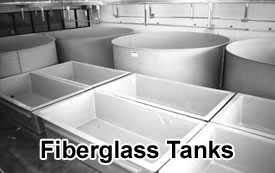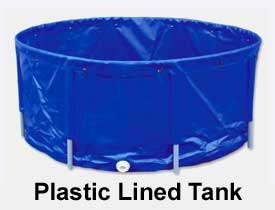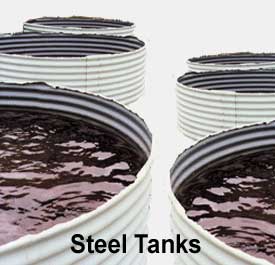Photos Courtesy of Aquatic Ecosystems, Inc.




 |
 |
 |
 |
Tanks for recirculation aquaculture have been made from a variety of materials. The key is that the tank material be inert, so it doesn't react with water or poison the fish, and be relatively inexpensive. The most commonly used materials are fiberglass, polyethylene, plastic liners inside a container, galvanized steel, concrete, and cement block. Earth, which is the most common pond material and used in raceway culture as well, is not commonly used in recirculation aquaculture because recirculation units are almost always indoors.
Plastic tanks (fiberglass and polyethylene) have the advantage of being totally inert and are easy to clean and sterilize. Polyethylene tanks are not as strong or rigid as fiberglass tanks and are not used in sizes over about 150 cm (5 feet) in diameter unless they are supported in some way. Self supporting fiberglass tanks up to 450 cm (15 feet) are available, though those over 300 cm (10 feet) are typically shipped in pieces and assembled on site. Fiberglass, though not the cheapest tank material, is the most popular because of its strength and durability.
Plastic liners are occasionally used, though they are not as durable as solid materials. Galvanized steel (such as cattle watering troughs) are often pressed into service in recirculation systems, but care must be used because new galvanizing can leach zinc into the water which is toxic to fish. Sometimes, steel frames are combined with liners to make large tanks. Poured concrete and cement block are used for the largest tanks, but new Portland cement is very alkaline and can raise the pH of the water. They are also somewhat porous and difficult to disinfect. Painting these tanks with a two part epoxy paint will form an impermeable coating and answer both of these drawbacks, but adds considerably to the expense.
Tanks are either rectangular or circular. Rectangular tanks may be somewhat square or long and narrow resembling raceways. The largest recirculation tanks are usually rectangular. Round tanks have an inherent advantage of being self-cleaning. If water enters the round tank under pressure and at an angle, a circular motion will be established. If a center drain is used for the water to flow out of the tank, fish waste and uneaten food will tend to be swept toward the center and out the center drain. This is why round tanks are said to be "self cleaning".
This center drain can be constructed several ways. Perhaps the simplest is to have dual standpipes at the center. The outer standpipe has slots at the bottom to admit the waste and not the fish. The waste would then be swept up and out of the inner standpipe, open at the top, that defines the water height. There is a tendency for heavier waste to clog between the inner and outer standpipes and the inner pipe must be periodically pulled to drain this waste. Another alternative is to have an external standpipe. In this design, there is no standpipe in the tank . The water flows out of the center drain and then up a pipe on the outside of the tank that defines the water height. Fish screen can be placed either over the drain inside the tank or in an overflow box where the external standpipe empties. A further refinement on this design is to have only a small volume (5-20%) of water flow out at the center drain with the bulk of the flow exiting through an overflow on the side of the tank (the overflow defines the water height in this case). This dual drain system developed at Cornell University has the advantage of concentrating the solid waste in a smaller volume of water...the first step in solids removal.
|
|